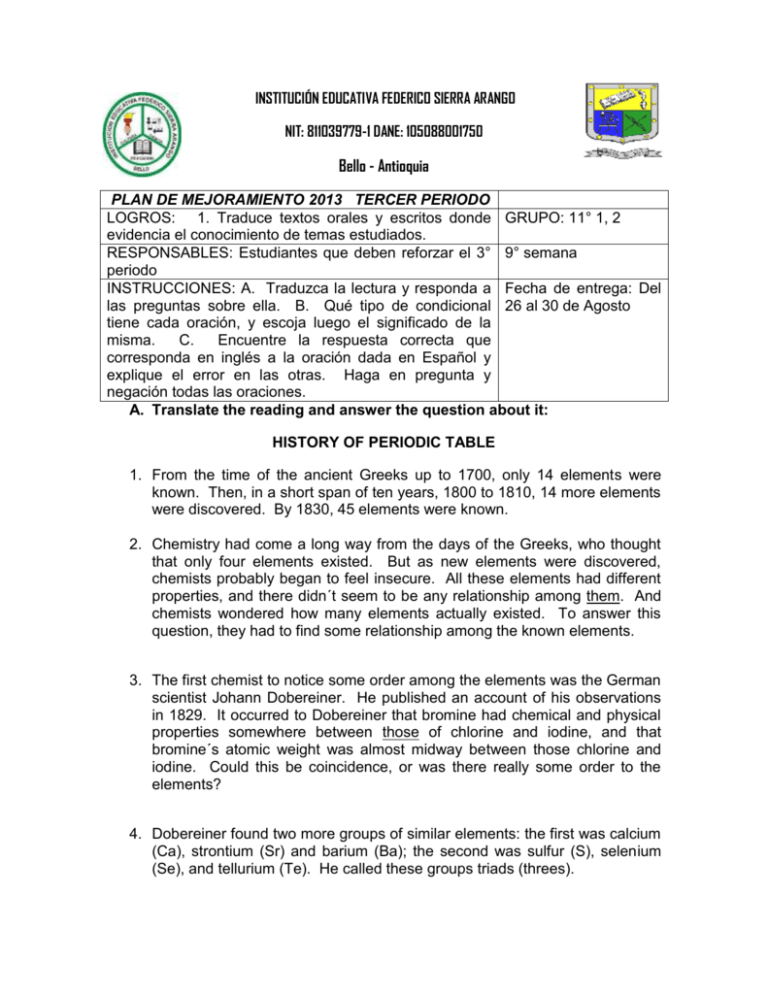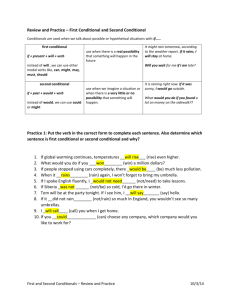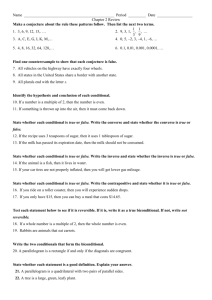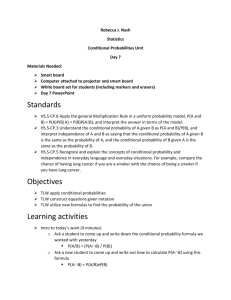Bello - Antioquia
advertisement

INSTITUCIÓN EDUCATIVA FEDERICO SIERRA ARANGO NIT: 811039779-1 DANE: 105088001750 Bello - Antioquia PLAN DE MEJORAMIENTO 2013 TERCER PERIODO LOGROS: 1. Traduce textos orales y escritos donde GRUPO: 11° 1, 2 evidencia el conocimiento de temas estudiados. RESPONSABLES: Estudiantes que deben reforzar el 3° 9° semana periodo INSTRUCCIONES: A. Traduzca la lectura y responda a Fecha de entrega: Del las preguntas sobre ella. B. Qué tipo de condicional 26 al 30 de Agosto tiene cada oración, y escoja luego el significado de la misma. C. Encuentre la respuesta correcta que corresponda en inglés a la oración dada en Español y explique el error en las otras. Haga en pregunta y negación todas las oraciones. A. Translate the reading and answer the question about it: HISTORY OF PERIODIC TABLE 1. From the time of the ancient Greeks up to 1700, only 14 elements were known. Then, in a short span of ten years, 1800 to 1810, 14 more elements were discovered. By 1830, 45 elements were known. 2. Chemistry had come a long way from the days of the Greeks, who thought that only four elements existed. But as new elements were discovered, chemists probably began to feel insecure. All these elements had different properties, and there didn´t seem to be any relationship among them. And chemists wondered how many elements actually existed. To answer this question, they had to find some relationship among the known elements. 3. The first chemist to notice some order among the elements was the German scientist Johann Dobereiner. He published an account of his observations in 1829. It occurred to Dobereiner that bromine had chemical and physical properties somewhere between those of chlorine and iodine, and that bromine´s atomic weight was almost midway between those chlorine and iodine. Could this be coincidence, or was there really some order to the elements? 4. Dobereiner found two more groups of similar elements: the first was calcium (Ca), strontium (Sr) and barium (Ba); the second was sulfur (S), selenium (Se), and tellurium (Te). He called these groups triads (threes). 5. In 1864 the English chemist John Newlands tried to arrange all the known elements in order of increasing atomic weight. He hit on the idea of arranging them in vertical columns. Since he noticed that the eighth element (sodium) had chemical and physical properties called his arrangement the Law of Octaves. But there were many places in his arrangement where dissimilar elements were next to each other. 6. In 1869 the Russian chemist Dmitri Mendeleev arranged the elements so that their order depended on the similarity of their chemical properties. Mendeleev established horizontal rows, or periods. Hydrogen by itself made up the first period. The next two periods each contained seven elements. The periods after that contained more than seven elements. This is the point at which Mendeleev´s table differed from Newlands´ table. 7. In arranging his table, Mendeleev occasionally put heavier elements before lighter ones in order to keep elements with the same chemical properties in the same vertical column (group). Sometimes he left open spaces in the table, where he reasoned that unknown elements would go. This was the case with gallium. In 1869, when he made up his table, the element gallium was unknown; however, Mendeleev predicted its existence. He based his theory on the properties of aluminum (which appeared directly above gallium on the table). Mendeleev even went so far as to predict the melting point, boiling point, and atomic weight of the then-unknown gallium, which he called eka-aluminum. Then, six year later, while analyzing zinc ore, the French chemist Lecoq de Boisbaudran discovered the element gallium. Its properties were identical to those Mendeleev had predicted six years carlier. 8. The periodic table of today is similar to Mendeleev´s; however, many new elements have been discovered since 1869. Today´s table consists of seven horizontal rows called periods and a number of vertical columns called groups (or families). The groups are numbered with roman numerals. Because they have the same numbers of electrons in their outer shells, elements in a particular group behave in similar ways. 9. You´ll notice that in the periodic table some of the groups are labeled with a roman numeral followed by A, others with a roman numeral followed by B. The A groups are called the representative elements. The B groups are called the transition metals. You can also see that, as we move from the top to the bottom of the periodic table (in other words, from period 1 to period 7), the periods get larger; they have more elements in them. In fact, periods 6 and 7 are so large (32 elements in each) that to fit the table on one page, we have to write part of each period bellow the rest of the table (the 15 lanthanides and 15 actinides). 1. What do the underlined words in the text refers to? “Them” in the second paragraph: 2. What do the underlined words in the text refers to? “Those” in the 3° paragraph 3. What do the underlined words in the text refers to? “each other” 5° paragraph 4. What do the underlined words in the text refers to? “That” and “this” in the 6° paragraph 5. What do the underlined words in the text refers to? “Ones”, “this”, “later” in the 7° paragraph 6. What do the underlined words in the text refers to? “They” in the 8° paragraph 7. What do the underlined words in the text refers to? “You” in the 9° paragraph B. Make a list of the scientists mentioned in the reading and their discoveries: Scientist discoveries ____________________________ ____________________________ ____________________________ ____________________________ ____________________________ ____________________________ ____________________________ ____________________________ ___________________________ C. Fill in the blanks with the word that correctly completes the sentence 8. Chemical elements ______________in their properties. 9. The chemical and physical properties of bromine are _____________from those of chlorine 10. Mendeleev grouped together elements with _____________chemical properties. 11. Calcium and Strontium belong to the ______________group in Döbereiner’s classification 12. There’s a great ____________between the first periodic table and today’s. 13. There is a ______________between the periodic table of today and that of Mendeleev D. Find which kind of conditional is the sentence and the translation in to Spanish 14. If I eat so much, I would be very fat a. Zero conditional b. First conditional c. Second conditional d. It is not any of these conditionals 15. The translation is: a. Si como mucho, engordaré b. Si comiera mucho me engordaría c. Si comería mucho, yo iré a engordar d. Si voy a comer mucho, engordo 16. Whether or not I go a. Zero conditional b. First conditional c. Second conditional d. It is not any of these conditionals 17. The translation is: a. Por el tiempo voy b. Si o no voy c. El tiempo o no para ir d. Sea por sí o no, yo voy 18. They are going to have a good time if you go to the party a. Zero conditional b. First conditional c. Second conditional d. It is not any of these conditionals 19. The translation is: a. Ellas la van a pasar bien si tú vas a la fiesta b. Ellos la pasarán bien si tú vas a la fiesta c. Ellas la pasarían bien si tú vas a la fiesta d. Ellos la pasan bien si tú vas a la fiesta 20. If He had played well, he would be in the team: a. Zero conditional b. First conditional c. Second conditional d. It is not any of these conditionals 21. The meaning of the sentence is: a. Si él hubiera jugado bien, estaría en el equipo b. Si él ha jugado bien, estará en el equipo c. Si él juega bien, estará en el equipo d. Si él habría jugado bien, va a estar en el equipo 22. Find the correct answer that in English correspond to the sentence given in Spanish, and explain the mistake in the others. After that, make the question and negative form for all of them: 23. Él se ha diverttido jugando en la casa. a. He would have a good time playing in the house. b. He had a good time play in the house. c. He has a good time playing in the house. d. He have had a good time playing in the house. 24. Ellas han estado tratando de dormir. a. They have been trying to sleep. b. They were been trying to sleep. c. They are going to try to sleep. d. They will be trying to sleep. 25. Tú estuviste estudiando mucho. a. You was studying very much. b. You are studying very much. c. You will be studying very much. d. You were studying very much. 26. El jugador de futbol ha estado descansando a. The soccer’s player has been resting. b. The soccer’s player will have resting. c. The soccer’s player is resting. d. The soccer’s player would rest. 27. Las damas han recogido las quejas a. The ladies were collecting claims. b. The ladies would collect claims. c. The ladies are going to collect claims. d. The ladies had collected claims.






